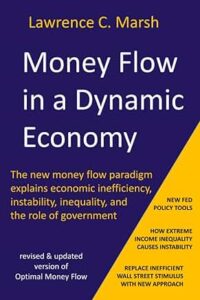Title: Money Flow in a Dynamic Economy: The New Money Flow Paradigm Explains Economic Inefficiency, Instability, Inequality and the Role of Government
Author: Lawrence Capron Marsh
Publisher: Avila University Press
ISBN: 978-0982852101
Pages: 271
Genre: Money & Monetary Policy
Reviewer: Jack Chambers
Hollywood Book Reviews
One of the biggest debates in the United States has to be centered around the economy. Whether you are the average citizen struggling to make the money you need to survive, or you are a politician or business tycoon debating laws which will impact the rise of cost and job opportunities in the country, economics plays a pivotal role in every person’s life. The toughest job of all is looking for a means of making a steady income, and not fighting just for scraps – but looking for a true way of bringing in money on a regular basis.
With that in mind, author Lawrence Capron Marsh leads readers into a thought-provoking book on the benefits and history of money flow in the book Money Flow in a Dynamic Economy: The New Money Flow Paradigm Explains Economic Inefficiency, Instability, Inequality and the Role of Government. The book sticks to its namesake, following the idea of money flow. In this book, the author reveals the ways in which the money flow paradigm has shown how much the United States, as a whole, has fallen behind economically in terms of growth and productivity. Through this system and the research the author has collected, the book looks to show how the government can change how the Federal Reserve can be better utilized and how they can contribute to the idea of a free enterprise system at the same time.
What really stood out about this book was how the author was able to maintain a great balance between intricately detailed financial discussions while also having enough room to speak to the average reader in terms they could understand. The depth of history and study of economics the author was able to establish early on in the book, allowed the reader to feel a sense of honest reflection and expertise in the author’s writing, and the way the author was able to outline the details in which the government can contribute to the distribution of good money flow. This includes creating a “FedAccount”, a system in which the Federal Reserve creates market accounts for everyone over 18 years old and with a social security number, that would allow them to pay businesses directly without the need to write a check out of their own personal account, and keeping cash flow moving rather than moving funds directly through the New York Markets.
This is the perfect read for those who enjoy non-fiction books, particularly those with a passion for finances and the economy; or books which speak of stimulating the economy and creating a better financial system with the government at the heart of the market. The concept of finances and the cash flow system being marketed by the author as a blood flow found in the human body, with this new system needing the government to become the beating heart of the system which keeps the “blood”, in this case the money, flowing smoothly was something readers would instantly be able to relate to, and kept them engaged with the author’s thorough study of this possible new system that would help boost the United States economy both on a local and world stage.

